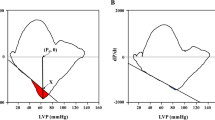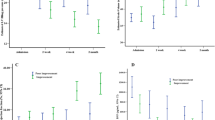Abstract
The objective of this manuscript was to explore if left ventricular ejection fraction (LVEF) and left ventricular fractional shortening (LVFS) could predict the efficacy of metoprolol therapy on vasovagal syncope (VVS) in children. Forty-nine children, including 30 with VVS and 19 gender- and age-matched healthy controls, were included in the study. Metoprolol was prescribed to the VVS subjects. The clinical data were obtained during follow-up at 2 and 6 months. The results showed that LVEF and LVFS of responders were significantly higher than those of non-responders both at the 2-month follow-up (LVEF: 72.5 ± 3.2% vs. 64.6 ± 3.4%; LVFS: 40.9 ± 2.3% vs. 34.9 ± 2.9%), and at the 6-month follow-up (LVEF: 72.8 ± 2.8% vs. 65.5 ± 4.6%; LVFS: 41.1 ± 1.9% vs. 35.8 ± 3.6%). The receiver operating characteristic curve (ROC) analysis demonstrated that 70.5% as a cutoff value of baseline LVEF yielded a sensitivity of 80% and a specificity of 100% in predicting the therapeutic effectiveness of metoprolol at 2 months. For baseline LVFS, 38.5% as a cutoff value yielded a sensitivity of 90% and a specificity of 90%. At the 6-month follow-up, the ROC analysis demonstrated that 70.5% as a cutoff value of baseline LVEF yielded a sensitivity of 81.3% and a specificity of 88.9% in the prediction of metoprolol efficacy. For baseline LVFS, 37.5% as a cutoff value yielded a sensitivity of 93.8% and a specificity of 66.7%. In conclusion, baseline LVEF and LVFS might be useful predictors of the efficacy of β-blocker therapy on VVS in children.


Similar content being viewed by others
References
Yang JY, Wang C, Tian H, Wang HW, Liao Y, Chen L, Zhang FW, Wang YL, Liu P, Zhang QY, Chen YH, Zhang CY, Du JB, Jin HF (2014) The analysis of the underlying disease spectrum of transient loss of consciousness in children. Int J Pediatr 41:195–197,201. https://doi.org/10.3760/cma.j.issn.1673-4408.2014.02.024
McHarg ML, Shinnar S, Rascoff H, Walsh CA (1997) Syncope in childhood. Pediatr Cardiol 18:367–371. https://doi.org/10.1007/s002469900202
Stewart JM (2013) Common syndromes of orthostatic intolerance. Pediatrics 131:968–980. https://doi.org/10.1542/peds.2012-2610
Stewart JM (2009) Postural tachycardia syndrome and reflex syncope: similarities and differences. J Pediatr 154:481–485. https://doi.org/10.1016/j.jpeds.2009.01.004
Sheldon RS, Grubb BP, Olshansky B, Shen WK, Calkins H, Brignole M, Raj SR, Krahn AD, Morillo CA, Stewart JM, Sutton R, Sandroni P, Friday KJ, Hachul DT, Cohen MI, Lau DH, Mayuga KA, Moak JP, Sandhu RK, Kanjwal K (2015) 2015 Heart rhythm society expert consensus statement on the diagnosis and treatment of postural tachycardia syndrome, inappropriate sinus tachycardia, and vasovagal syncope. Heart Rhythm 12:e41-63
Ding YY, Wang C, Liu XY, Lin P, Wu LJ, Xue XH, Li MX, Kumar P, Hu CY (2009) The relationship between vasovagal syncope and anxiety in children. Chin J Pract Pediatr 24:536–538
Ding YY, Wang C, Wu LJ, Hu CY, Lin P (2010) Psychological factors of children with vasovagal syncope. J Appl Clin Pediatr 25:437–439
Ding YY, Wang C, Lin P, Li MX, Xue XH, Liu XY, Wu LJ, Hu CY, P Kumar (2009) Relationship between vasovagal syncope and depression in children. Chin J Crit Care Med 29:17–20. https://doi.org/10.3969/j.issn.1002-1949.2009.01.005
Shen WK, Sheldon RS, Benditt DG, Cohen MI, Forman DE, Goldberger ZD, Grubb BP, Hamdan MH, Krahn AD, Link MS, Olshansky B, Raj SR, Sandhu RK, Sorajja D, Sun BC, Yancy CW (2017) 2017 ACC/AHA/HRS guideline for the evaluation and management of patients with syncope: executive summary: a report of the American College of Cardiology/American Heart Association Task Force on Clinical Practice Guidelines, and the Heart Rhythm Society. Heart Rhythm 14:e218-254. https://doi.org/10.1016/j.hrthm.2017.03.005
Chen L, Du JB, Zhang QY, Wang C, Du ZD, Wang HW, Tian H, Chen JJ, Wang YL, Hu XF, Li WZ, Han L (2007) A multicenter study on treatment of autonomous nerve-mediated syncope in children with beta-receptor blocker. Chin J Pediatr 45:885–888. https://doi.org/10.3760/j.issn:0578-1310.2007.12.002
Zhang FW, Liao Y, Li XY, Chen L, Jin HF, Du JB (2011) Follow-up study of the efficacy of different therapies on vasovagal syncope in children with different hemodynamic patterns. Chin J Pract Pediatr 26:97–100
Zhang QY, Du JB, Li WZ, Wang YL (2006) The efficacy of midodrine hydrochloride in the treatment of children with vasovagal syncope. Chin J Pract Pediatr 21:826–828
Grubb BP (1999) Pathophysiology and differential diagnosis of neurocardiogenic syncope. Am J Cardiol 84:3Q–9Q
Kinsella SM, Tuckey JP (2001) Perioperative bradycardia and asystole: relationship to vasovagal syncope and the Bezold-Jarisch reflex. Br J Anaesth 86:859–868
Zhang QY, Du JB, Zhen JL, Li WZ, Wang YL (2007) Hemodynamic changes during head-up tilt test and predictive value thereof in predicting the efficacy of metoprolol therapy in children with vasovagal syncope. Natl Med J China 87:1260–1262. https://doi.org/10.3760/j.issn:0578-1310.2007.12.002
Lin J, Jin HF, Du JB (2014) Assessment of therapeutic biomarkers in the treatment of children with postural tachycardia syndrome and vasovagal syncope. Cardiol Young 24:792–796. https://doi.org/10.1017/S1047951114000316
Edner M, Brodin LK, Al-Khalili F, Svane B, Moor E, StÅhle A, Nordiander R (1998) Changes in systolic and diastolic function indexes throughout dobutamine stress echocardiography in healthy volunteers and patients with ischemic heart disease. Echocardiography 15:625–634
Zheng HP, Li WZ, Li Y, Ma YW, Chen YH, Du JB (1999) Evaluation of cardiac beta-adrenergic receptor responsiveness in children by dobutamine stress echocardiography. Chin Med J (Engl) 112:623–626. https://doi.org/10.3760/j.issn:0578-1310.1999.06.017
Chu WH, Wang C, Wu LJ, Lin P, Li F, Zou RM (2015) Oral rehydration salts: an effective choice for the treatment of children with vasovagal syncope. Pediatr Cardiol 36:867–872. https://doi.org/10.1007/s00246-015-1097-5
Winker R, Barth A, Bidmon D, Ponocny I, Weber M, Mayor O, Robertson D, Diedrich A, Maier R, Pilger A, Haber P, Rüdiger HW (2005) Endurance exercise training in orthostatic intolerance: a randomized, controlled trial. Hypertension 45:391–398. https://doi.org/10.1161/01.HYP.0000156540.25707.af
Li HX, Wang YL, Liu P, Chen YH, Feng XL, Tang CS, Du JB, Jin HF (2016) Body mass index (BMI) is associated with the therapeutic response to oral rehydration solution in children with postural tachycardia syndrome. Pediatr Cardiol 37:1313–1318. https://doi.org/10.1007/s00246-016-1436-1
Bondanelli M, Alboni P, Margutti A, Franceschetti P, Dinelli M, Gruppillo P, Marchi P, Degli UE (2003) Plasma galanin response to head-up tilt in normal subjects and patients with recurrent vasovagal syncope. Metabolism 52:315–321. https://doi.org/10.1053/meta.2003.50051
Alboni P, Dinelli M, Gruppillo P, Bondanelli M, Bettiol K, Marchi P, Degli UE (2002) Haemodynamic changes early in prodromal symptoms of vasovagal syncope. Europace 4:333–338
Sra JS, Murthy V, Natale A, Jazayeri MR, Dhala A, Deshpande S, Sheth M, Akhtar M (1994) Circulatory and catecholamine changes during head-up tilt testing in neurocardiogenic (vasovagal) syncope. Am J Cardiol 73:33–37
Zygmunt A, Stanczyk J (2004) Heart rate variability in children with neurocardiogenic syncope. Clin Auton Res 14:99–106. https://doi.org/10.1007/s10286-004-0168-0
Jian PJ, Du JB, Zhang QY (2006) Effect of metoprolol treatment in vasovagal syncope in children. J Appl Clin Pediatr 21:305–306. https://doi.org/10.3969/j.issn.1003-515X.2006.05.022
Wang C, Xu Y, Liu XY, Hu CY, Praveen K, Wu LJ, Hu EL, Cui XL, Xie ZW (2009) Intervention study of midodrine hydrochloride and metoprolol in the treatment of children vasovagal syncope. Chin J Crit Care Med 29:196–199. https://doi.org/10.3969/j.issn.1002-1949.2009.03.002
Wang XR (2016) Effect of metoprolol on children with vasovagal syncope. Chin J Pract Med 43:10–11. https://doi.org/10.3760/cma.j.issn.1674-4756.2016.03.004
Zhang FW, Liao Y, Li XY, Chen L, Jin HF, Du JB (2012) The predictive value of flow-mediated vasodilation on therapeutic efficacy of midodrine hydrochloride for vasovagal syncope in children. Chin J Pract Pediatr 27:102–105
Younoszai AK, Franklin WH, Chan DP, Cassidy SC, Allen HD (1998) Oral fluid therapy. A promising treatment for vasodepressor syncope. Arch Pediatr Adolesc Med 152:165–168
Nishi I, Iida K, Kawano S, Masumi T, Yamaguchi I (2001) Using isoproterenol stress echocardiography to predict the response to carvedilol in patients with dilated cardiomyopathy. Jpn Circ J 65:514–518
Kawano S, Iida K, Fujieda K, Yukisada K, Magdi ES, Iwasaki Y, Tabei F, Yamaguchi I, Sugishita Y (1995) Response to isoproterenol as a prognostic indicator of evolution from hypertrophic cardiomyopathy to a phase resembling dilated cardiomyopathy. J Am Coll Cardiol 25:687–692. https://doi.org/10.1016/0735-1097(94)00432-P
Kelbaek H, Christensen NJ, Godtfredsen J (1988) Left ventricular volumes during graded upright exercise in healthy untrained subjects. Clin Physiol 8:51–56
Halter JB, Stratton JR, Pfeifer MA (1984) Plasma catecholamines and hemodynamic responses to stress states in man. Acta Physiol Scand Suppl 527:31–38
Stratton JR, Pfeifer MA, Ritchie JL, Halter JB (1985) Hemodynamic effects of epinephrine: concentration-effect study in humans. J Appl Physiol 58:1199–1206
Stratton JR, Halter JB, Hallstrom AP, Caldwell JH, Ritchie JL (1983) Comparative plasma catecholamine and hemodynamic responses to handgrip, cold pressor and supine bicycle exercise testing in normal subjects. J Am Coll Cardiol 2:93–104
Kanstrup IL, Marving J, Gadsbøll N, Lønborg-Jensen H, Høilund-Carlsen PF (1995) Left ventricle haemodynamics and vaso-active hormones during graded supine exercise in healthy male subjects. Eur J Appl Physiol Occup Physiol 72:86–94
Funding
This work was supported by Beijing Municipal Science and Technology Major Project (No. Z171100001017253, Beijing, China) and National Youth Top-notch Talent Support Program (China). There has been no other financial support for this work that could have influenced its outcome. The funding agencies had no other involvement, such as study design; the collection, analysis, and interpretation of data; writing the report; and in the decision to submit the article for publication in this work.
Author information
Authors and Affiliations
Corresponding authors
Ethics declarations
Conflict of interest
The authors declare that they have no conflict of interest. This manuscript is approved by all authors for publication.
Ethical Approval
All procedures performed in studies involving human participants were in accordance with the ethical standards of the institutional and/or national research committee and with the 1964 Helsinki declaration and its later amendments or comparable ethical standards.
Informed Consent
Informed consent was obtained from all individual participants included in the study.
Rights and permissions
About this article
Cite this article
Song, J., Li, H., Wang, Y. et al. Left Ventricular Ejection Fraction and Fractional Shortening are Useful for the Prediction of the Therapeutic Response to Metoprolol in Children with Vasovagal Syncope. Pediatr Cardiol 39, 1366–1372 (2018). https://doi.org/10.1007/s00246-018-1904-x
Received:
Accepted:
Published:
Issue Date:
DOI: https://doi.org/10.1007/s00246-018-1904-x




